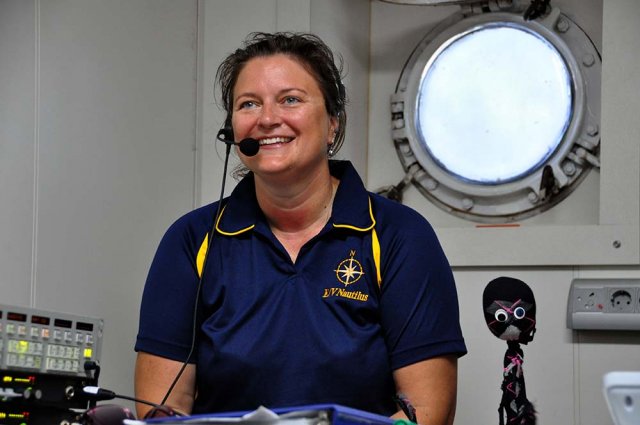The Adventure of a Lifetime

It was “anchors aweigh!” for Melissa (Elam ’95) Baffa, a science communication fellow with the Ocean Exploration Trust. For three weeks in June she was aboard the E/V Nautilus 230 miles northeast of the Galápagos Islands in the eastern Pacific (west of Ecuador), exploring hydrothermal vent systems with scientists Dr. Robert Ballard and other members of the Corps of Exploration, funded by the Ocean Exploration Trust (OET). Through the voyage Melissa and her colleagues hope to better understand the dynamic environments present where tectonic plates meet, including hydrothermal vents.
A biology major at Cal Lutheran, Melissa is the Vice President of Program and Volunteer Services for the Girl Scouts of California’s Central Coast. She flew to Panama to start her trip, and then spent 31Ž2 days aboard the ship just traveling to the Galápagos. Once there, she and her group deployed two unmanned robotic vehicles named Argus and Hercules to study life near hydrothermal vents at the bottom of the ocean, more than 8,000 feet deep. She was onboard only for only a short leg of the season (which lasts for six months total), but that time was memorable.
“It was absolutely incredible,” she said. “I like to stretch myself and do things that are a little scary. I knew I’d be traveling alone internationally for the first time, away from my family. I was also a little worried about keeping up with the pace on board the ship.”
Baffa and other members of the Corps of Exploration stood four- to six-hour watches during dives. As the science communication fellow, Baffa’s responsibilities included answering questions that came in through the Nautilus Live website from all over the world. Using cutting-edge technology, the OET is able to beam hi-resolution images from thousands of feet under the sea in nearly real-time through the Internet, and people around the world are able to write in with comments and questions. “I learned so much! The idea of doing something scary in order to grow is a good one.”
The Nautilus follows in some famous footsteps. In 1835, Charles Darwin visited the Galápagos aboard the HMS Beagle and made important geological and biological observations there. Today, these islands also provide insights into our knowledge of the chemistry of the Earth’s interior and changes in the plate tectonics of the eastern Pacific seafloor.
Through the Ocean Exploration Trust Science Communication Fellowship program, formal and informal educators can apply to participate in ocean exploration and research. Fellows engage in training in early spring, and then commit to a one- to three-week stint aboard the ship during the research season. The Trust also offers a summer research program for high school students, as well as an internship program for undergraduate and graduate students. Melissa, like previous science communication fellows, plans to share her experiences through her job, in this case with nearly 11,000 Girl Scouts residing in six counties along the California coast. She has already written a six-part series for the Ventura County Star, blog postings for the Girl Scouts website, and hosted a collaborative event with the Museum of Ventura County. Future events throughout the council’s six-county footprint are in the planning stages.
To read more about Melissa’s voyage, visit the Girl Scouts blog . To learn more about about the Nautilus and its many discoveries this season, and possibly participate in a deep-sea dive LIVE, click here . Educators interested in the science communication fellowship program may click here .
More
- Hispanic Heritage Month Highlight: Diana J. De Schutter '15
October 11, 2021 - Traveling the World & Creating Lifelong Memories
April 28, 20212021 Outstanding Alumni Award Winner
Jane Lee '78 Winter - Trailblazer for Inclusion
April 28, 20212020 Outstanding Young Alumni Award Winner
Benjamin Hogue ’10, MDiv ’18 - Introducing Cal Lutheran's 2019 Alumni Hall of Fame Class
June 18, 2019 - Accomplishing Greater Things, Together
May 20, 20192019 Outstanding Alumni Award Winner
Tracy M. Downs '88, M.D. - The Business of Neurodiversity
December 7, 20182018 Outstanding Young Alumni Award Winner
Oliver Thornton '16 - 2018-2019 Alumni Awards
September 10, 2018Honoring Oliver Thornton ’16, Tracy Downs ’88, M.D., and Paul Hanson, Ph.D.
- Collaborating for Cal Lutheran's Future
May 7, 20182018 Honorary Alumni Award Winner
Siri Eliason - Find the Right Wall for Your Ladder
April 6, 20182018 Outstanding Young Alumni Award Winner
Chris Kajtor '07, MPPA '10 - All Roads Lead to Family (and Coffee!)
November 9, 20172017 Outstanding Alumni Award Winner
Michael Adinew '94